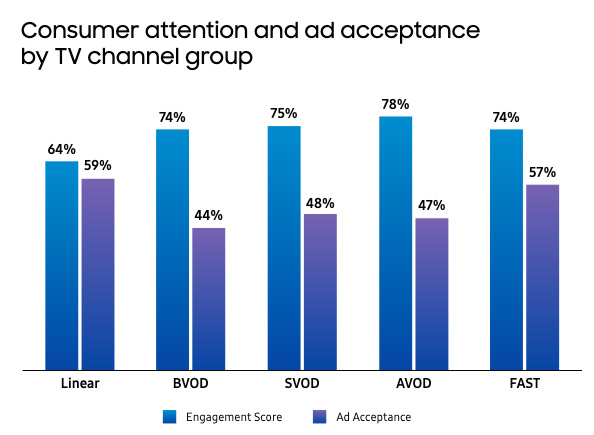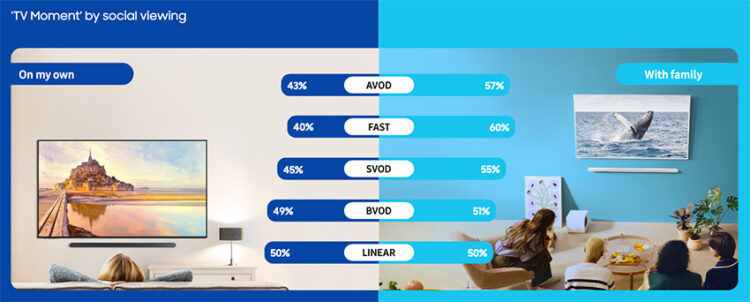Majority of UK population finds VOD ads disruptive

More than half of the UK population (52%) dislike ads or find them disruptive, presenting significant challenges for agencies and marketers, a new study suggested.
Samsung Ads’ Change the Way You CTV report, in partnership with Isba and conducted by LongTerm CoLab, surveyed 1,600 people in the UK about their TV behaviours.
By channel, people are most tolerant of ads on linear (59%), followed by free ad-supported TV (FAST, at 57%).
Perhaps unsurprisingly, channels with higher engagement generally had lower ad acceptance levels.
Speaking to The Media Leader, Matt Bryan, director of analytics and insights at Samsung Ads Europe, said: “Because viewers have always expected ads on linear and FAST, we see higher ad acceptance on these channels, whereas SVOD [subscription VOD] platforms now face the challenge of bringing ads into an environment that has been ad-free to date, making ads less welcome.
“As users start to adapt to the new tiered SVOD models and an ad-centric experience across CTV, we can start thinking about TV as a whole ecosystem again. And then it will come down to advertisers understanding how and when the balance between engagement and acceptance falls best for both sides of the screen.”

Millennial viewers less tolerant of ads
Ad acceptance also varies by age. Generally, the older people are, the more tolerant they are of advertising: ad acceptance was at 67% for those aged 65-plus and 59% for 55-64s.
The lowest tolerance was found in the 35-44 age group at just 33%. According to the report, this generation of viewers began consuming content before the peak of YouTube and the tech boom, thus predating the widespread monetisation on channels and platforms.
In contrast, tolerance is higher for Gen Z (49%). As Bryan explained: “Gen Z are surprisingly open to advertising, which is likely shaped by their exposure to creator-led social platforms and ads that interrupt their feed, so it’s not just a case of young versus old.”
The study also pointed out that this group is likely to opt for streaming subscriptions with ads.
In this context, relevancy becomes key. Bryan noted: “Advertisers have all the information they need to make sure they are providing relevant ad experiences — first-party data provides accurate insights into CTV viewership for better targeting, measurement and optimisation.
“Similarly, brands should tailor the type of ad they use for the audience they’re looking to target. Consider whether shorter video creative and more engaging formats would help to deliver a punchy message to an impatient audience or if a longer video creative, like John Lewis’ famous ads, could generate engagement in the brand story.”
Samsung Ads’ survey also delved deeper into ad tolerance by genre. It found that viewers were most tolerant of advertising when viewing crime/drama/fantasy, followed by the news and kids/family.
Top opportunities for advertisers
Based on its data about engagement, ad acceptance and genres, Samsung Ads was able identify the top three opportunities that maximised ad acceptance and engagement. They are “news catching”, “evening escaping” and “family time”.
Furthermore, the study found that shared viewing increases ad acceptance significantly.
According to the findings, more than 50% of viewing takes place as “family viewing” across all video channels, with FAST the highest at 60%. While 48% of solo viewers reported being tolerant of ads, this figure rose to 55% for when viewing with a partner and 57% when viewing as a family.

This makes co-viewing an “immensely powerful” trend for brands and marketers to tap into, according to the report, despite the broader decline in live, linear TV viewership.
Bryan said: “By designing ads that specifically resonate in a social setting, to spark conversation or encourage engagement in the room, brands can leverage the moments of togetherness in the same way that they used to for big cultural moments, like The X Factor final.
“Focusing on shared viewing creates micro-cultural moments in every household across the UK.”




